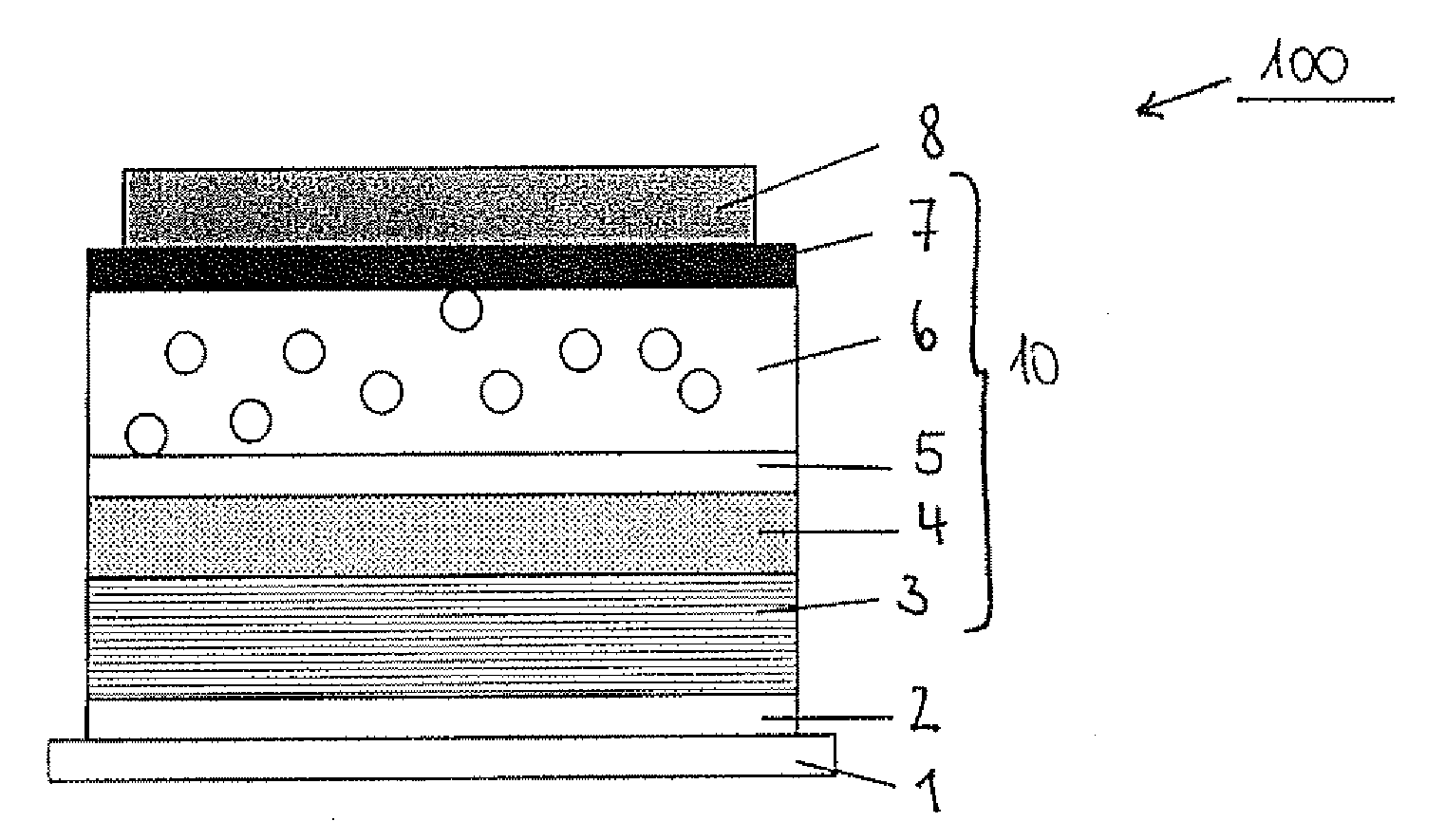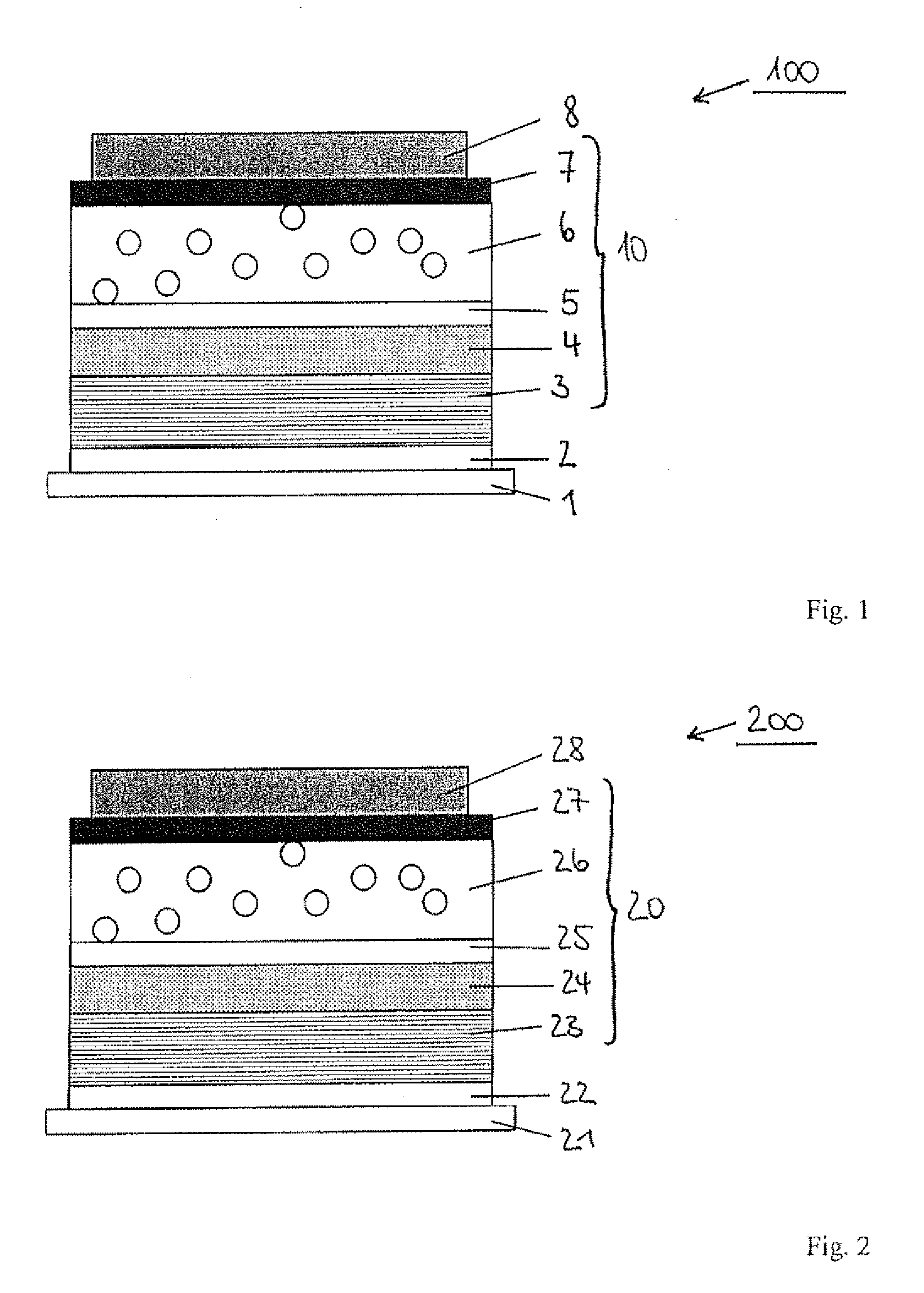Light-Emitting Component
a technology of light-emitting components and components, which is applied in the direction of organic semiconductor devices, electroluminescent light sources, thermoelectric devices, etc., can solve the problems of not more than two different polymer layers, the sequence of the structure of a given material system can be changed with a great amount of difficulty, and disadvantages, etc., to achieve good structure capability of light-emitting devices, improve the flexibility of structure, and improve the injection of charge carriers
- Summary
- Abstract
- Description
- Claims
- Application Information
AI Technical Summary
Benefits of technology
Problems solved by technology
Method used
Image
Examples
example 1
[0080]According to an example 1 the light-emitting device has the following structure, which comprises a low-molecular organic injection layer from donor molecules of an organic material:[0081]1.1 transparent substrate (glass)[0082]1.2 anode contact (indium tin oxide ITO; 90 nm thick)[0083]1.3 polymer hole injection layer, (PEDOT:PSS (Baytron-P of H.C. Starck, Germany); 80 nm thick (spin-coated from watery dispersion)[0084]1.4 polymer hole transporting emission layer (MEH-PPV; 70 nm thick (spin-coated from toluene solution)[0085]1.7 low-molecular donor molecule layer (W2(Xpp)4; 2 nm thick)[0086]1.8 cathode contact (reflecting; Al)
example 2
[0087]According to an example 2 the light-emitting device has the following structure, which comprises a low-molecular organic injection layer from donor molecules of an organic material:[0088]2.1 transparent substrate (glass)[0089]2.2 anode contact (indium tin oxide ITO; 90 nm thick)[0090]2.3 polymer hole injection layer, (PEDOT:PSS (Baytron-P of H.C. Starck, Germany); 80 nm thick (spin-coated from watery dispersion)[0091]2.4 polymer hole transporting emission layer (MEH-PPV; 60 nm thick (spin-coated from toluene solution)[0092]2.6 n-doped low-molecular electron transport layer (from Alq3 doped with W2(Xpp)4, mass doping concentration 20% (corresponds to a molar doping concentration of approx. 10%); 20 nm thick)[0093]2.7 low-molecular donor molecule layer (W2(Xpp)4; 2 nm thick)[0094]2.8 cathode contact (reflecting; Al)
[0095]By means of the insertion of the n-doped electron transport layer 2.6, the optic cavity of the hybrid device can be adapted without incurring losses with regard...
example 3
[0096]According to an example 3 the light-emitting device has the following structure, which comprises a low-molecular organic injection layer from donor molecules of an organic material:[0097]3.1 transparent substrate (glass)[0098]3.2 anode contact (indium tin oxide ITO; 90 nm thick)[0099]3.3 polymer hole injection layer, (PEDOT:PSS (Baytron-P of H.C. Starck, Germany); 80 nm thick (spin-coated from watery dispersion)[0100]3.4 polymer hole transporting emission layer (MEH-PPV; 60 nm thick (spin-coated from toluene solution)[0101]3.6 low-molecular electron transport layer (from Alq3; 20 nm thick)[0102]3.7 low-molecular donor molecule layer (W2(Xpp)4; 2 nm thick)[0103]3.8 cathode contact (reflecting; Al)
[0104]In contrast to example 2, this device has a non-doped low-molecular electron transport layer. Compared with example 2, there were slight losses with regard to the measured operating voltage as a result. However, a mixed evaporation process can be dispensed with.
PUM
| Property | Measurement | Unit |
|---|---|---|
| reduction potential | aaaaa | aaaaa |
| reduction potential | aaaaa | aaaaa |
| reduction potential | aaaaa | aaaaa |
Abstract
Description
Claims
Application Information
 Login to View More
Login to View More - R&D
- Intellectual Property
- Life Sciences
- Materials
- Tech Scout
- Unparalleled Data Quality
- Higher Quality Content
- 60% Fewer Hallucinations
Browse by: Latest US Patents, China's latest patents, Technical Efficacy Thesaurus, Application Domain, Technology Topic, Popular Technical Reports.
© 2025 PatSnap. All rights reserved.Legal|Privacy policy|Modern Slavery Act Transparency Statement|Sitemap|About US| Contact US: help@patsnap.com


